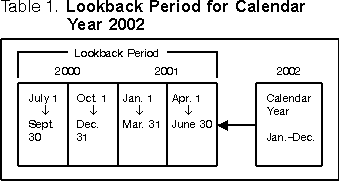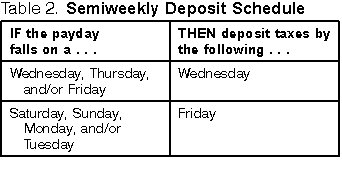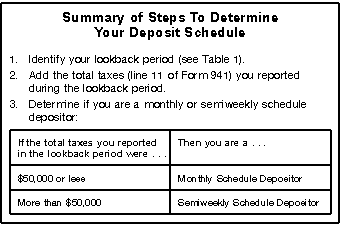 |
IRS Tax Forms |
Rose Co. is a monthly schedule depositor for 2001 because its tax liability for the four quarters in its lookback period (third quarter 1999 through second quarter 2000) was not more than $50,000. However, for 2002, Rose Co. is a semiweekly schedule depositor because the total taxes exceeded $50,000 for the four quarters in its lookback period (third quarter 2000 through second quarter 2001). Deposits on Banking Days Only If a deposit is required to be made on a day that is not a banking day, the deposit is considered timely if it is made by the close of the next banking day. In addition to Federal and state bank holidays, Saturdays and Sundays are treated as nonbanking days. For example, if a deposit is required to be made on a Friday and Friday is not a banking day, the deposit will be considered timely if it is made by the following Monday (if that Monday is a banking day). Semiweekly schedule depositors have at least 3 banking days to make a deposit. That is, if any of the 3 weekdays after the end of a semiweekly period is a banking holiday, you will have one additional banking day to deposit. For example, if a semiweekly schedule depositor accumulated taxes for payments made on Friday and the following Monday is not a banking day, the deposit normally due on Wednesday may be made on Thursday (allowing 3 banking days to make the deposit). Application of Monthly and Semiweekly Schedules The terms "monthly schedule depositor" and "semiweekly schedule depositor" do not refer to how often your business pays its employees or even how often you are required to make deposits. The terms identify which set of deposit rules you must follow when an employment tax liability arises. The deposit rules are based on the dates wages are paid; not on when tax liabilities are accrued. Monthly schedule example. Spruce Co. is a monthly schedule depositor with seasonal employees. It paid wages each Friday. During March it paid wages but did not pay any wages during April. Under the monthly deposit schedule, Spruce Co. must deposit the combined tax liabilities for the four March paydays by April 15. Spruce Co. does not have a deposit requirement for April (due by May 15) because no wages were paid and, therefore, it did not have a tax liability for April. Semiweekly schedule example. Green Inc., which has a semiweekly deposit schedule, pays wages once each month on the last day of the month. Although Green Inc. has a semiweekly deposit schedule, it will deposit just once a month because it pays wages only once a month. The deposit, however, will be made under the semiweekly deposit schedule as follows: Green Inc.'s tax liability for the July 31, 2002 (Wednesday) payday must be deposited by August 7, 2002 (Wednesday). Under the semiweekly deposit schedule, liabilities for wages paid on Wednesday through Friday must be deposited by the following Wednesday. $100,000 Next-Day Deposit Rule If you accumulate a tax liability (reduced by any advance EIC payments) of $100,000 or more on any day during a deposit period, you must deposit the tax by the next banking day, whether you are a monthly or semiweekly schedule depositor. For purposes of the $100,000 rule, do not continue accumulating tax liability after the end of a deposit period. For example, if a semiweekly schedule depositor has accumulated a liability of $95,000 on a Tuesday (of a Saturday-through-Tuesday deposit period) and accumulated a $10,000 liability on Wednesday, the $100,000 next-day deposit rule does not apply. Thus, $95,000 must be deposited by Friday and $10,000 must be deposited by the following Wednesday. In addition, once you accumulate at least $100,000 in a deposit period, stop accumulating at the end of that day and begin to accumulate anew on the next day. For example, Fir Co. is a semiweekly schedule depositor. On Monday, Fir Co. accumulates taxes of $110,000 and must deposit this amount on Tuesday, the next banking day. On Tuesday, Fir Co. accumulates additional taxes of $30,000. Because the $30,000 is not added to the previous $110,000 and is less than $100,000, Fir Co. must deposit the $30,000 by Friday following the semiweekly deposit schedule. If you are a monthly schedule depositor and accumulate a $100,000 tax liability on any day, you become a semiweekly schedule depositor on the next day and remain so for at least the rest of the calendar year and for the following calendar year. Example: Elm Inc. started its business on April 1, 2002. On April 16, it paid wages for the first time and accumulated a tax liability of $40,000. On April 23, 2002, Elm Inc. paid wages and accumulated a liability of $60,000, bringing its accumulated tax liability to $100,000. Because this was the first year of its business, the tax liability for its lookback period is considered to be zero, and it would be a monthly schedule depositor based on the lookback rules. However, since Elm Inc. accumulated a $100,000 liability on April 23, it became a semiweekly schedule depositor on April 24. It will be a semiweekly schedule depositor for the remainder of 2002 and for 2003. Elm Inc. is required to deposit the $100,000 by April 24, the next banking day. Accuracy of Deposits Rule You are required to deposit 100% of your tax liability on or before the deposit due date. However, penalties will not be applied for depositing less than 100% if both of the following conditions are met:
Makeup Date for Deposit Shortfall:
For example, if a semiweekly schedule depositor has a deposit shortfall during July 2002, the shortfall makeup date is August 16, 2002 (Friday). However, if the shortfall occurred on the required October 2 (Wednesday) deposit due date for a September 25 (Wednesday) pay date, the return due date for the September 25 pay date (October 31) would come before the November 15 (Friday) shortfall makeup date. In this case, the shortfall must be deposited by October 31.
How To DepositThe two methods of depositing employment taxes, including Form 945 taxes, are discussed below. See page 17 for exceptions explaining when taxes may be paid with the tax return instead of deposited. Electronic deposit requirement. You must make electronic deposits of all depository taxes (such as employment tax, excise tax, and corporate income tax) using the Electronic Federal Tax Payment System (EFTPS) in 2002 if:
If you are required to use EFTPS and fail to do so, you may be subject to a 10% penalty. If you are not required to use EFTPS, you may participate voluntarily. To get more information or to enroll in EFTPS, call 1-800-555-4477 or 1-800-945-8400. Depositing on time. For deposits made by EFTPS to be on time, you must initiate the transaction at least one business day before the date the deposit is due. Making deposits with FTD coupons. If you are not making deposits by EFTPS, use Form 8109, Federal Tax Deposit Coupon, to make the deposits at an authorized financial institution. For new employers, the IRS will send you a Federal Tax Deposit (FTD) coupon book 5 to 6 weeks after you receive an employer identification number (EIN). (Apply for an EIN on Form SS-4.) The IRS will keep track of the number of FTD coupons you use and automatically will send you additional coupons when you need them. If you do not receive your resupply of FTD coupons, call 1-800-829-1040. You can have the FTD coupon books sent to a branch office, tax preparer, or service bureau that is making your deposits by showing that address on Form 8109-C, FTD Address Change, which is in the FTD coupon book. (Filing Form 8109-C will not change your address of record; it will change only the address where the FTD coupons are mailed.) The FTD coupons will be preprinted with your name, address, and EIN. They have entry boxes for indicating the type of tax and the tax period for which the deposit is made. It is very important to clearly mark the correct type of tax and tax period on each FTD coupon. This information is used by the IRS to credit your account. If you have branch offices depositing taxes, give them FTD coupons and complete instructions so they can deposit the taxes when due. Please use only your FTD coupons. If you use anyone else's FTD coupon, you may be subject to the failure to deposit penalty. This is because your account will be underpaid by the amount of the deposit credited to the other person's account. See Deposit Penalties on page 21 for details. How to deposit with an FTD coupon. Mail or deliver each FTD coupon and a single payment covering the taxes to be deposited to an authorized depositary. An authorized depositary is a financial institution (e.g., a commercial bank) that is authorized to accept Federal tax deposits. Follow the instructions in the FTD coupon book. Make the check or money order payable to the depositary. To help ensure proper crediting of your account, include your EIN, the type of tax (e.g., Form 941), and tax period to which the payment applies on your check or money order. Authorized depositaries must accept cash, a postal money order drawn to the order of the depositary, or a check or draft drawn on and to the order of the depositary. You may deposit taxes with a check drawn on another financial institution only if the depositary is willing to accept that form of payment. Be sure that the financial institution where you make deposits is an authorized depositary. Deposits made at an unauthorized institution may be subject to the failure to deposit penalty. If you prefer, you may mail your coupon and payment to Financial Agent, Federal Tax Deposit Processing, P.O. Box 970030, St. Louis, MO 63197. Make your check or money order payable to Financial Agent. Depositing on time. The IRS determines whether deposits are on time by the date they are received by an authorized depositary. To be considered timely, the funds must be available to the depositary on the deposit due date before the institution's daily cutoff deadline. Contact your local depositary for information concerning check clearance and cutoff schedules. However, a deposit received by the authorized depositary after the due date will be considered timely if the taxpayer establishes that it was mailed in the United States at least 2 days before the due date. Note: If you are required to deposit any taxes more than once a month, any deposit of $20,000 or more must be made by its due date to be timely. Depositing without an EIN. If you have applied for an EIN but have not received it, and you must make a deposit, make the deposit with the IRS. Do not make the deposit at an authorized depositary. Make it payable to the "United States Treasury" and show on it your name (as shown on Form SS-4), address, kind of tax, period covered, and date you applied for an EIN. Send an explanation with the deposit. Do not use Form 8109-B, Federal Tax Deposit Coupon, in this situation. Depositing without Form 8109. If you do not have the preprinted Form 8109, you may use Form 8109-B to make deposits. Form 8109-B is an over-the-counter FTD coupon that is not preprinted with your identifying information. You may get this form by calling 1-800-829-1040. Be sure to have your EIN ready when you call. Use Form 8109-B to make deposits only if--
Deposit record. For your records, a stub is provided with each FTD coupon in the coupon book. The FTD coupon itself will not be returned. It is used to credit your account. Your check, bank receipt, or money order is your receipt. How to claim credit for overpayments. If you deposited more than the right amount of taxes for a quarter, you can choose on Form 941 for that quarter to have the overpayment refunded or applied as a credit to your next return. Do not ask the depositary or EFTPS to request a refund from the IRS for you.
Deposit PenaltiesPenalties may apply if you do not make required deposits on time, make deposits for less than the required amount, or if you do not use EFTPS when required. The penalties do not apply if any failure to make a proper and timely deposit was due to reasonable cause and not to willful neglect. For amounts not properly or timely deposited, the penalty rates are:
Order in which deposits are applied. Beginning in 2002, deposits generally are applied to the most recent tax liability within the quarter. For examples on how the IRS will apply deposits, see Rev. Proc. 2001-58 (2001-50 I.R.B. 579). Before 2002, deposits generally were applied first to the oldest tax liability. However, if you receive a failure-to-deposit penalty notice, you may designate how your payment is to be applied in order to minimize the amount of the penalty. Follow the instructions on the penalty notice you receive. For more information on designating deposits, see Revenue Procedure 99-10 (1999-1 C.B. 272). You can find Rev. Proc. 99-10 on page 11 of Internal Revenue Bulletin 1999-2 at www.irs.gov. Example: Cedar Inc. is required to make a deposit of $1,000 on April 15 and $1,500 on May 15. It does not make the deposit on April 15. On May 15, Cedar Inc. deposits $2,000. Under the new rule, which applies deposits to the most recent tax liability, $1,500 of the deposit is applied to the May 15 deposit and the remaining $500 is applied to the April deposit. Accordingly, $500 of the April 15 liability remains undeposited. The penalty on this underdeposit will apply as explained above. Trust fund recovery penalty. If income, social security, and Medicare taxes that must be withheld are not withheld or are not deposited or paid to the United States Treasury, the trust fund recovery penalty may apply. The penalty is the full amount of the unpaid trust fund tax. This penalty may apply to you if these unpaid taxes cannot be immediately collected from the employer or business. The trust fund recovery penalty may be imposed on all persons who are determined by the IRS to be responsible for collecting, accounting for, and paying over these taxes, and who acted willfully in not doing so. A responsible person can be an officer or employee of a corporation, a partner or employee of a partnership, an accountant, a volunteer director/trustee, or an employee of a sole proprietorship. A responsible person also may include one who signs checks for the business or otherwise has authority to cause the spending of business funds. Willfully means voluntarily, consciously, and intentionally. A responsible person acts willfully if the person knows the required actions are not taking place. Separate accounting when deposits are not made or withheld taxes are not paid. Separate accounting may be required if you do not pay over withheld employee social security, Medicare, or income taxes; deposit required taxes; make required payments; or file tax returns. In this case, you would receive written notice from the IRS requiring you to deposit taxes in a special trust account for the U.S. Government. You would also have to file monthly tax returns on Form 941-M, Employer's Monthly Federal Tax Return. Publication Index | IRS-Forms Main | Home © 2004, UncleFed.com
|
|||||||||||||||||||||||||||||||||||||||||||||||


